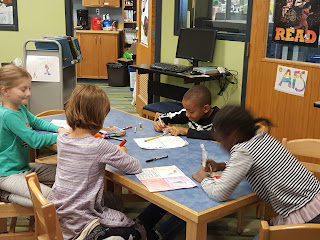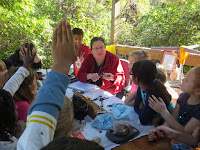Third graders have been hard at work studying the moon in
our classroom, at home, and in science class this month. As part of cultural immersion into the
Mid-Autumn Moon Festival, we have been learning about the moon through
research, but also taking time to appreciate the moon’s beauty and
majesty. Last week, we
noticed that the moon could still be seen in the morning. “It’s a waning gibbous!” a few students
exclaimed, as they walked into the classroom. The muted and understated presence of the moon stood in
wondrous contrast to the fiery red of the treetops above which the moon hung in
the morning breeze. That
morning, we went to take a brief look at the moon, but then we decided we
needed an extended time to gaze and commune with the moon.
The next day, we wandered out into the dewy front lawn,
eager to see the moon. For the
first 20 minutes, the moon briefly showed itself, but then stayed hidden among
the clouds. Still, we dutifully
sketched the sky, trees, and clouds around it. Then, all of a sudden, the moon’s brilliant edges shone
through and we were all able to watch the moon for just enough time until it
disappeared again. After our game
of hide-and –seek with the moon, we sat down together to reflect. Students shared about different points
in time when seeing the moon was meaningful to them – in the quiet of the
morning when no one else was awake, or in their backyard in the open air of
Oklahoma. Logan shared about what a privilege it was to be able
to go out to see the moon as a class.
“When I grow up, I know that I’m going to look back and remember that we
did this together.” All three of us teachers glanced at each
other briefly – and we knew that we would also look back and remember our
experience delighting in the moon together with this class.



























































